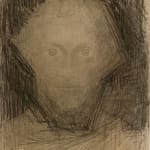Bart van der Leck (1876-1958)
Further images
Bart van der Leck remains one of the most enigmatic figures of De Stijl, often overshadowed by his contemporaries. Like Mondriaan, he was over forty when he finally developed the characteristic abstract style for which he is celebrated today. Aloof and opinionated, Van der Leck kept the artworld at arm’s length, forming few close friendships. Aside from his student years in Amsterdam, he lived outside cultural centers, rarely exhibiting his work. His art was scarcely seen abroad as he avoided travel and preferred the solitude of his studio. On a stipend from art patron Helene Kröller-Müller for several years, one of the first women to assemble a major collection of old masters and modern art, most of Van der Leck’s work can be found in the Kröller-Müller Museum in Otterlo.
Bremmer’s judgment in purchasing works of art was decisive for hundreds of collectors in The Netherlands. Although especially associated with Vincent van Gogh, of whom Bremmer was not the first but the most successful posthumous propagandist, whoever was approved by the visionary art advisor could count on steady support from Dutch collectors. Bremmer’s zeal for art had traits of a religion, his captive audience resembling disciples, known as ‘Bremmerians’, many of whom inspired to start their own collection.
Behind Helene Kröller-Müller’s commitment to Van der Leck, was her advisor H.P. Bremmer. Bremmer and Van der Leck’s long-lasting friendship dates to 1908.[1] In Charley Toorop’s large group portrait from the late 1930s, Van der Leck is prominently placed between Bremmer and his wife. Bremmer ensured Van der Leck’s financial stability by securing him an annuity. From 1912 to 1945, the artist received a near-continuous stipend from the art advisor in exchange for his studio production.[2] During 1914-1918 and 1920-1921, Helene Kröller Müller covered these costs, further explaining the limited international exposure.[3]
Among Bremmer’s disciples was psychiatrist G.W. Arendsen Hein, who attended Bremmer’s lessons in Utrecht and Amsterdam from 1930 to 1938.[4] Arendsen Hein regarded Bremmer as a father figure and lifelong inspiration, crediting him as the biggest contributor to his general education.[5] Bremmer’s classes in the 1930s were formative for the psychiatrist Arendsen Hein, being absorbed by the philosophical, ethical, and religious discussions. During this period, Bremmer most likely sold the present esoteric Head—his typical inscriptions in capitals elucidating the art—to his disciple, a fitting choice for a head doctor renowned for pioneering LSD treatment in the late 1950s.[6]
Van der Leck’s Head foreshadows Mondriaan’s self-portraits from 1908, followed by his angular Evolution tryptic from 1911.[7] While Bremmer revered Van der Leck’s ‘generalization of reality,’ he felt the artist’s complete abstraction in 1918 went too far and was unsalable, convinced that Mondriaan had overly influenced Van der Leck, leading him in a direction that was not his own. Van der Leck left De Stijl he co-founded the previous year and distanced himself from its strict geometric abstraction.
[1] Cees Hilhorst, Vriendschap op afstand. De Correspondentie tussen Bart van der Leck en H.P. Bremmer, Bussum 1999, pp. 18-20
[2] Hildelies Balk, De kunstpaus H.P. Bremmer 1871-1956, Bussum 2006, p. 214
[3] Hilhorst, op.cit., “Bijlage II Overzicht jaarlijkse uitkeringen”, pp. 201-208[4] “De cursisten van H.P. Bremmer”, in: Hilde Alice Balk, De kunstpaus H.P. Bremmer 1871-1956, dissertation Vrije Universiteit Amsterdam 2004, p. 654
[5] Balk 2006, op.cit., pp. 165-166
[6] Dr. Arendsen Hein began LSD therapy in 1959, when he was chief psychiatrist at the Salvation Army clinic Groot Batelaar in Lunteren. This facility specialized in treatment of “criminal psychopaths,” sentenced by the judicial courts to psychiatric care. Later, he used LSD therapy at his private clinic Veluweland, near Groot Batelaar, where patients were discreetly referred to as guests, reflecting their higher social status. Classified as “neurotics” they were further distinguished from the judicially mandated patients of Groot Batelaar. According to Balk, Arendsen Hein owned nine paintings, four sculptures and seven tiles by Van der Leck, op.cit., 2006, p. 204, fn. 644, p. 491
[7] Smaller self-portraits by Mondriaan from 1908 can be found in the Kunstmuseum as well [object.no. 0631554 & 0631555], although the angularity of his (self)portraits would not appear until 1912.
Provenance
H.P. Bremmer (1871-1956), The Hague, by whom sold in the 1930s toG.W. Arendsen Hein (1912-1995), The Netherlands, by descent
Private collection, The Netherlands
De Zwaan Auction House, Amsterdam, 15 May 2024, lot 6483





